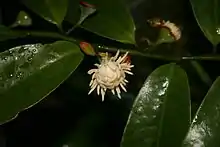Eupomatia laurina
Eupomatia laurina, commonly named bolwarra or sometimes native guava or copper laurel, is a species of shrubs to small trees, of the Australian continent ancient plant family Eupomatiaceae. They often grow between 3 and 5 m (10 and 16 ft) tall, larger specimens may attain 15 m (50 ft) and a trunk diameter of 30 cm (12 in).[2] They grow naturally in eastern Australia and New Guinea. In Australia, they grow as far south as Nowa Nowa in the humid forests of the warm temperate east of the state of Victoria through eastern New South Wales and Queensland north to tropical Cape York Peninsula.[2][3][4] They are one of the ancient lineages of flowering plants, usually growing as part of an understorey in rainforests or humid Eucalypt forests.[2][3][4]
| Eupomatia laurina | |
|---|---|
 | |
| Bolwarra flowering in cultivation in Sydney | |
| Scientific classification | |
| Kingdom: | Plantae |
| Clade: | Tracheophytes |
| Clade: | Angiosperms |
| Clade: | Magnoliids |
| Order: | Magnoliales |
| Family: | Eupomatiaceae |
| Genus: | Eupomatia |
| Species: | E. laurina |
| Binomial name | |
| Eupomatia laurina | |
They have glossy leaves, oblong–elliptic shaped, from 5 to 20 cm (2 to 8 in) long. The branches bear the globose to urn-shaped fruits of a green external colour, measuring 15–20 mm (0.6–0.8 in) diameter and yellowing when ripe with pale coloured edible jelly flesh inside, interspersed by many non-edible seeds (similar appearance to guava contents).[2][3][4] Germination from fresh seed commences after around three weeks and completes after five weeks, with a high level of germination. Flowers pollinated by small weevils, including Elleschodes hamiltoni and others in the same genus. Cuttings are not advised as a method of regeneration.[2]
The sweet, aromatic fruit is used as a spice-fruit in cooking, being included in beverages, jams and desserts. It is best used in combination with other ingredients that complement its strong flavour, and hence should be considered one of the Australian spices.
In cultivation E. laurina is frost sensitive and prefers a protected, semi-shaded site. It can be propagated from seed or cuttings. Cutting propagated trees produce fruit after two years. Seedlings take four to six years to fruit.
The whole genus known to science includes only two other species, each one only known from occurrences in small localised areas of Australia and separated from each other by over 1,000 km (620 mi). E. bennettii (small bolwarra) occurs only in the north-eastern New South Wales to south-eastern Queensland region and E. barbata (northern small bolwarra) in the Wet Tropics of Queensland.
References
- "Eupomatia laurina R.Br.". Australian Plant Name Index (APNI), IBIS database. Centre for Plant Biodiversity Research, Australian Government. Retrieved 19 Nov 2013.
- Floyd, Alex G. (2008). Rainforest Trees of Mainland South-eastern Australia. Inkata Press. p. 156. ISBN 978-0-9589436-7-3.
- Hyland, B. P. M.; Whiffin, T.; Zich, F. A.; et al. (Dec 2010). "Factsheet – Eupomatia laurina". Australian Tropical Rainforest Plants (6.1, online version RFK 6.1 ed.). Cairns, Australia: Commonwealth Scientific and Industrial Research Organisation (CSIRO), through its Division of Plant Industry; the Centre for Australian National Biodiversity Research; the Australian Tropical Herbarium, James Cook University. Retrieved 19 Nov 2013.
- Cooper, Wendy; Cooper, William T. (June 2004). "Eupomatia laurina R.Br.". Fruits of the Australian Tropical Rainforest. Clifton Hill, Victoria, Australia: Nokomis Editions. p. 199. ISBN 9780958174213. Archived from the original on 9 April 2013. Retrieved 19 Nov 2013.